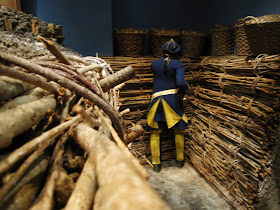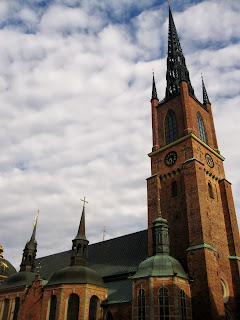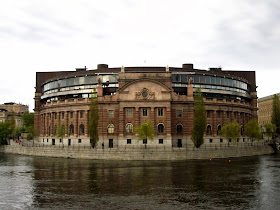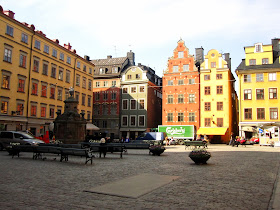Some new history is being made in the English Channel.
Researchers have just retrieved a rare Dornier Do-17 bomber from 50 feet of water. The German bomber was part of the Luftwaffe raids on Britain in 1940 before it was crippled on the return flight home and crashed into the Channel.
German Bomber Lifted
The plane will be restored and put on display. I love these kind of finds.
On a similar note, I really hope the Smithsonian Air and Space Museum moves ahead with the restoration of another German aircraft: the Horten Ho-229 flying wing. This one-of-a-kind aircraft is the world's first flying wing jet fighter. The US B-2 Spirit is said to be inspire by/ based off this 1944 design. Tests of a model a few years back confirmed that the plane possessed stealth qualities which reduced its size by 20% on English radar.
Pages
▼
Thursday, 13 June 2013
Wednesday, 29 May 2013
Best. Exhibition. Ever.
When I was at the Arme Museum in Stockholm, I came across a small room. It was pitch black with barely enough space for eight people to stand shoulder to shoulder. A single pane of glass stretched across it's length with dim yellow light emanating behind it. There, barely illuminated, were six or seven banners, ragged and torn, their colors faded with time. Nearby were two regimental drums, their heads punched in so they could drum no more. These artifacts were the relics of Narva; Russian trophies captured on the battlefield in what was Charles XII's greatest victory. And all the while, you could hear the steady droning of Russian Orthodox gregorian chant.
I've seen some awe-inspiring displays across the world, but never has an exhibit given me such pause as the Narva trophies. It was but a darkened room with the visitor directly opposite the artifacts and yet there was this mystical, sacred feeling. For all the exhibit's simplicity, the sense of history was overwhelming.
Just goes to show that sometimes you don't need flashy multimedia or hands-on displays to get the point across.
The museum was kind enough to give me the album name and I believe this is the song I heard:
I've seen some awe-inspiring displays across the world, but never has an exhibit given me such pause as the Narva trophies. It was but a darkened room with the visitor directly opposite the artifacts and yet there was this mystical, sacred feeling. For all the exhibit's simplicity, the sense of history was overwhelming.
Just goes to show that sometimes you don't need flashy multimedia or hands-on displays to get the point across.
The museum was kind enough to give me the album name and I believe this is the song I heard:
Saturday, 25 May 2013
Kingdom For A Heart
Last March I gave a lecture at the University of New Hampshire on the courtship of Henry VIII and Anne Boleyn. I just uploaded the video to youtube so feel free to check it out!
And the link: KINGDOM FOR A HEART
And the link: KINGDOM FOR A HEART
Tuesday, 21 May 2013
Stockholm Pt. 2
Charles XII edition!
My main reason for travelling to Stockholm was to find anything associated with my current history fascination. Thankfully, there was plenty to see! I hope to incorporate my photography into a future lecture similar to my "Kingdom For A Heart" talk last year.
My main reason for travelling to Stockholm was to find anything associated with my current history fascination. Thankfully, there was plenty to see! I hope to incorporate my photography into a future lecture similar to my "Kingdom For A Heart" talk last year.
Charles XII never wore the grand outfits of kings. He felt most comfortable in a soldier's uniform and led a spartan life alongside his men. He is noted for abstaining from alcohol and women which has led to accusations of homosexuality.
Print of a contemporary image of Charles. He shunned wigs which were growing in fashion amongst the European courts and wore his hair cropped like that of his soldiers.
Charles received a statue on the 150th anniversary of his death in 1868. He wears his beloved cavalry uniform with an outstretched arm pointing towards Russia and the site of his only, but catastrophic, defeat at Poltava.
The following pictures are presented in chronological order according to the life of Charles XII:
Whistle toys belonging to the infant Charles. A piece of his foetal membrane is preserved on the black felt below. According to superstition, if a royal infant is born with part of the membrane on their head (like a caul), they are destined for greatness.
Karlbergs Slott: This palace is where he spent his early childhood. He also laid in state here before his internment at Riddarholms Kyrkan.
Karlbergs Slott is now a Swedish military academy.
Wrangelska Palatset. When the Tre Kronor Fortress/ Palace burnt down in 1697 (Charles' ascension year), the court moved to this location just across the water on Riddarholmen.
The pocket-watch of Charles XII. It shows all the providences of the Swedish Empire at the time.
While not associated with Charles, this phrase over a church gate fits his views perfectly: "Fear God, Honor Thy King". At his coronation, Charles crowned himself. He believed he was ordained by God, not by the church and expected absolute obedience. In fact, he was Sweden's last true absolute monarch. With his death, the Age of Liberty began.
"All embrace me, its my time to rule at last. 15 years have I been waiting to sit upon my throne. No allegiance, I will swear no oath! Crowned by God, not by the church as my power is divine" -Sabaton
On the island of Skeppsholmen, Charles built the "West Residence" which housed his bodyguard unit. Because they were away on duty, the empty building was used to house the poor.
Swedish cavaliers.
When Charles ascended to the throne at the age of 15, his enemies sought to take advantage of his supposed inexperience. Russia, Poland and Denmark allied together and initiated the Great Northern War (1700-1721). Charles secured swift and decisive victories early on and knocked both Denmark and Poland out of the war. The highwater mark was the victory at Narva. Charles then invaded Russia and set a precedent that plagued Napoleon and Hitler in the centuries to come. At Poltava, the Swedish army was crushed. Denmark and Poland then reneged on their treaties and re-entered the war. Charles tried to take Norway (then part of Denmark) in 1716 and again in 1718. The latter ended with his death outside of Fredriksten fortress (see my post on Norway a few weeks back).
"I have resolved never to start an unjust war but never to end a legitimate one except by defeating my enemies" -Charles XII
A drum from the Great Northern War with the monogram of Charles XII.
An ammunition bag.
The Swedes employed the "cold steel" tactic. Marching in rank, they would fire off only one volley before charging the enemy with fixed bayonets. Close quarter combat was preferred over ranged.
An example of Swedish trench works...perhaps similar to those built outside Fredriksten.
A rather plain regimental banner.
Gustaf Cederstrom's painting of Charles XII after the battle of Poltava. Because of the king's numerous injuries (note the wounded foot), he could not lead his men directly. Given his noted ability to ignore even the worst of pains, that says something. Despite being massively outnumbered by the Russians, could he have led the army to victory? It is worth mentioning that he never lost a battle in which he held direct command. The king is considered one of the greatest generals of the period. Unfortunately for him, the Swedish Empire was unsustainable and its enemies too powerful. He was merely postponing the inevitable.
The Poltava Memorial outside of the Army Museum. It depicts Mother Svea (similar to Britannia for England or Liberty for America) unfurling a Swedish flag over a fallen soldier at Poltava. The inscription reads: "To The Fatherland's Fallen Sons".
"Rode to certain death and pain, Swedish soldiers met their bane, sacrificed their lives in vain, Poltava!" -Sabaton
When Charles lost at Poltava, he fled to the Ottoman Empire where he stayed for four years. Eventually the Turks had enough of him and attacked his garrison. Charles survived a sabre blow to the head thanks to the otterskin cap he was wearing (on the left). He fled to Swedish territory by disguising himself as a captain named Peter Frisk. The wig was part of that ploy. His 15 day ride became legend: "was sorgt ihr doch? Gott und ich leben noch". Translated: "what worries you so? God and I yet live".
Preserved at the royal armory is the uniform that Charles wore on the night of his death on November 30, 1718. Again, it is a standard cavalry uniform though the fabric is of finer quality. His boots are made from cow leather with wooden soles.
The mud from the trenches still clings to the bottom of his coat.
His felt hat still has the 19.5mm bullet hole, visible below the gold button. One historian has argued that this is crucial to deciding whether the king was killed by the enemy or from within. I tend to agree with him but that is for another post. His gloves are still bloodstained as his head sunk into his coat and fell onto his crossed arms.
The retreat from Norway after the king's death became known as the Carolean Death March. Because of a terrible blizzard and low supplies, fully half of the army never made it home.
The king was laid to rest at Riddarholms Kyrkan, the royal burial site.
The chapel in which the Carolean Kings lie was started in the 1660s. By 1697 the vault was complete but the structure required a wooden roof. It wasn't until 1742 that the chapel was complete.
If one subscribes to the theory that Charles was killed from within, Fredrick I is often seen as a major conspirator. Ironic then that he lies next to the man he had killed (supposedly).
The black marble sarcophagus of Charles XII. I always feel the overwhelming press of history when I stand near the tombs of the people I research. It is indescribable.
Another great picture of the king's statue at the Kungstradgarden.
"Broken dreams so grand, sing of his final stand, long live Carolus. Brought by a soldier's hand, back to the Fatherland, long live Carolus Rex" -Sabaton
Stockholm Pt. 1
Wow, couldn't have asked for better weather! What a trip! I saw everything I wanted to see and then some. Even got a private tour of the ruined Tre Kronor fortress underneath the current royal palace. Stockholm is definitely worth seeing. I can't stress that enough. It is easy to get to, fun to walk and there is something for everyone. Unlike many European cities that have been spoiled by war, Stockholm's old town (Gamla Stan) consists mostly of 16th and 17th century buildings. The alleys and cool cellars are blatant reminders of the town's past. The connection to the royalty is clearly visible with palaces seemingly around ever corner.
This post will be broken up into three sections over the next 2-3 days (have to do this because I took 564 pictures!). First we will look at sites/ architecture around Stockholm. Then we will look at sites and artifacts associated with Charles XII. Lastly, I'll add anything I may have missed. On with the show!
This post will be broken up into three sections over the next 2-3 days (have to do this because I took 564 pictures!). First we will look at sites/ architecture around Stockholm. Then we will look at sites and artifacts associated with Charles XII. Lastly, I'll add anything I may have missed. On with the show!
Stockholm!
The new parliament building which sits on its own little island.
Riddarhuset. Built in the 1640s in Dutch Baroque, it is considered Stockholm's most beautiful building.
Finska Kyrkan. One of the oldes buildings in Slottsbacken (located within Gamla Stan- "Old Town").
Stortorget. The well dates from 1778.
Stortorget. This was the site of the Stockholm Bloodbath in 1520. At the time, Sweden was under Danish rule. Over 80 Swedish nobles were executed in this square after feigned gestures of goodwill. This led to a Swedish uprising that put Gustav Vasa on the throne in 1523.
Gamla Stan is littered with alleys. All the buildings date from the 16th/17th centuries.
Queen Kristina's summer house. She was queen in the 17th century.
Riddarholms Kyrkan. This church is known for its royal burials and many of Sweden's most iconic monarchs are here: Gustav Vasa, Gustaf II Adolf, Karls X, XI, XII, Karl XIV Johan.
The western facade of the royal palace where the changing of the guard takes place. The current palace dates back to the early 18th century. The original fortress, known as Tre Kronor, burnt down in 1697. Remains of this building can still be seen under today's current structure.
The eastern facade.
Sweden's old parliament building from the late 19th century.
The Arme Museum.
Wednesday, 15 May 2013
Off To Stockholm!
Having been to Halden, the site of Charles XII's death, it is now time to go to his city of birth and the capital of the nation over which he reigned. From Thursday to Sunday I will find myself in Stockholm! The itinerary is quite packed and I will detail it below. As I am travelling, this blog will go silent until my return. Hopefully many pictures will accompany the next update. Unfortunately, this is my last trip before heading home. I've seen so much and yet missed out on so much more. But that is for another post.
Now then, what will I be doing?
Thur:
Livrustkammaren: The royal armories underneath the current palace. This museum houses all sorts of neat things on the Swedish monarchy such as Gustav Adolf's stuffed horse Streiff from Lutzen (1632), the costume that Gustav III wore on the night he was assassinated and the uniform that Charles XII wore when he was shot and killed in Norway.
Fri:
Karlbergs Slott: Charles XII was raised in this palace and also laid in state here.
Gamla Stan: Translates to "Old City". This is medieval/ baroque Stockholm with all the essential attractions belonging to the royalty.
Tre Kronor Museum: The old palace burnt down in 1697. This museum holds what few artifacts remain.
Riddarholm Church: The burial place for almost all of the Swedish monarchy including Gustav Adolf (1632) and Charles XII (1618).
Wrangelska Palaset: Another medieval palace.
Sat:
Charles XII and Gustav Adolf's statues.
Vasa Museum: The Vasa was Sweden's largest warship. She set sail on her maiden voyage in 1628 and made it about 2 km before she was caught in a gale and capsized. The Vasa was raised in the 1960s and is now preserved (75% original) in the museum.
Sun:
Skeppsholmen Buildings: Some of the buildings on this island were used as barracks to house Charles XII's bodyguard.
Armee Museum: A museum showcasing the history of the Swedish army. I am particularly interested in the Carolean period.
Now then, what will I be doing?
Thur:
Livrustkammaren: The royal armories underneath the current palace. This museum houses all sorts of neat things on the Swedish monarchy such as Gustav Adolf's stuffed horse Streiff from Lutzen (1632), the costume that Gustav III wore on the night he was assassinated and the uniform that Charles XII wore when he was shot and killed in Norway.
Fri:
Karlbergs Slott: Charles XII was raised in this palace and also laid in state here.
Gamla Stan: Translates to "Old City". This is medieval/ baroque Stockholm with all the essential attractions belonging to the royalty.
Tre Kronor Museum: The old palace burnt down in 1697. This museum holds what few artifacts remain.
Riddarholm Church: The burial place for almost all of the Swedish monarchy including Gustav Adolf (1632) and Charles XII (1618).
Wrangelska Palaset: Another medieval palace.
Sat:
Charles XII and Gustav Adolf's statues.
Vasa Museum: The Vasa was Sweden's largest warship. She set sail on her maiden voyage in 1628 and made it about 2 km before she was caught in a gale and capsized. The Vasa was raised in the 1960s and is now preserved (75% original) in the museum.
Sun:
Skeppsholmen Buildings: Some of the buildings on this island were used as barracks to house Charles XII's bodyguard.
Armee Museum: A museum showcasing the history of the Swedish army. I am particularly interested in the Carolean period.
Monday, 13 May 2013
Heavy Metal History \m/
For the people who have been following this blog from the beginning (so maybe three of you), you may have noticed that I occassionally supplement my posts with videos by a band called Sabaton. I thought I'd use a post to talk about them a bit more since they are basically heavy-metal-history.
First off, the name "Sabaton" sounds awesome! Truly metal! Of course, when you find out what it really is, you might do a double-take. A sabaton is the flexible plating that covers the top part of the foot in a suit of armor. No, really!
Sabaton is a heavy metal/ power metal band from Falun, Sweden. They are constantly growing in popularity, especially in Europe, due to their awesome shows and the content of their music. When you open for Judas Priest and Iron Maiden, you are doing something right. Anyways, Sabaton uses the history of warfare for their lyrical content. Battles, characters and themes throughout time are meticulously researched and then incorporated into song.
Part of their popularity stems from the fact that they cover the history of many countries. The Polish government has given the band several awards because of their songs "40:1" and "Uprising" depicting the heroism of the Polish during WWII. Germany, Greece, Sweden, Norway, England, Israel, US, Russia and others all get their time in the sun. I have included snapshots of each song and its corresponding context below (thanks to Wikipedia):
Album: Primo Victoria
Attero Dominatus
The Art of War
Coat of Arms
Carolus Rex (my favorite!)
I know of at least one example on youtube where a history teacher incorporates Sabaton's songs with archival footage and text and then presents the videos to his students. I've been thinking of doing the same:
Who loves Sabaton? I do!
Bringing your national flag to Sabaton concerts is encouraged.



















































